
You Do have a future.
Who would have thought so?
And that’s how it’s going to happen:
The planet you live on is not only great; it’s always morning somewhere. So there’s always a new beginning.
On your planet there’s enough food for everybody, enough energy to make life easy, enough resources to build machines, bridges and homes for everybody.
If you share this wealth, you’ll live comfortably, healthily and happily forever. What more could you wish for?
Now, for the small print.
If we want to share, we have to be honest and serious. Talking of energy, your share will be 1000 Watt. Watt is just a measure of energy conversion. It can take on the form of food calories, electricity, and fuels or of grey energy in all kinds of goods. To show you what this means: 1000 Watt, that’s for example a 1000 Watt lamp burning for you day and night. It can also be imagined as 10 robots working for you constantly (as a human, your energy out-put is about 100 Watt, if you’re in good shape). As our biosphere cannot take more than 100 billion such robots (even if they were solar-powered), 15 are the limit. (At present, people use 105 robots in the US, 53 in Europe, 10 in China, six in India and only one in Bangladesh.) Some of us will have to change their lifestyle; others can expand their energy consumption. You would not seriously want to suggest, that it’s fair that some use 100 times more than others? I hope.
Changing one’s lifestyle is easy; it just takes a little bit of imagination.
It means living closer together, using less space, giving up the idea of using individual cars, eating less meat – that’s it, basically. We’ll live more slowly, we’ll share space and other facilities, we’ll combine production and consumption on the spot, we’ll have more fun, less stress.
The basic locale of our new lifestyle will be the neighborhood. The people around us. This makes sense, doesn’t it?
If you live in one of the global neighborhoods (see below), your 1000-Watt share may mean:
- 200 sq foot (20 m2) of heated or cooled private living space in an insulated building
- no car
- no plane flights
- 6 miles (9 km) of train travel per day
- a train trip of 1400 miles (2000 km) per year
- a boat voyage of 8000 miles (12’000 km) per year
- 36 pounds (18 kg) of meat per year
- 18.5 gallons (70 l) of water per day
- 1 newspaper per ten inhabitants
This table doesn’t define the compulsory way of life. It only quantifies a possible mix of energy uses. If you don’t eat any meat at all, you might want to drive a car instead. People, who need more living space, can cut down on their train trips. Since they are happy living in their precious homes, they may not feel such a strong urge to travel. Within the limits of your share, a big variety of life-styles are possible. Your use of energy may also vary in different phases of your lifetime.
As for long boat-trips there are not enough boats available at present, in particular boats that are ecologically sound. The figure of a quota of voyages is only included in the list to show that transportation on water is the most energy-efficient and that we don’t have to give up planetary mobility. In terms of ecology investments in canal systems and in the technology of high-tech sailing vessels make more sense than investments in cars and planes. These are two examples for the new ecological design that must be developed in a continental and global context.
Now, for those of you who think they are entitled to a "normal western lifestyle" (car, single house, 60 kg of meat, flights etc.) this must look like bad news. The whole fabric of life as you know it seems to be unraveling in front of your eyes. On the other hand, for those 80 percent of our fellow planetarians who are living far below these standards, this global new deal sounds like a utopian promise. If we want some measure of global fairness, we should go for the new offer. The prospects without change look grim: ecological collapse, civil wars, and repression. The ecological impact of global warming will hit the poorer regions of the planet particularly hard. So ecology is intimately linked with justice. Environmental destruction is an externality of inequality.
The goal of a globally fair lifestyle cannot be reached through conscientious individuals, as a mere personal effort. It can only be reached by living together in a new way. Common uses of resources in turn require democratic forms of self-organization. Sharing doesn’t happen because you are a nice person; only in a community based on sharing will you be prepared to share. What goes around comes around. And you want to have a word on how to do it.
As to what these new democratic forms may look like, we can offer you a few ideas.
We have mentioned the neighborhood earlier. Remember?
neighborhood
Neighborhoods have always existed in the past and still exist in many different forms all over the planet today. Most of them have been torn apart and mangled by the forces of the market economy, by private ownership of land, by differences in wealth and income. Something we can do is to repair old neighborhoods and to create new ones where none existed before.
Neighborhoods can be rural or urban. At the moment the most urgent task is the re-establishment or creation of urban neighborhoods, for more than 50 per cent of all humans live in cities. In those regions of the planet where most of the ecological damage is done – US, Europe, Japan – 75 percent live in cities or city-like agglomerations. So the big challenge is the transformation of cities into socially and ecologically sustainable living spaces.
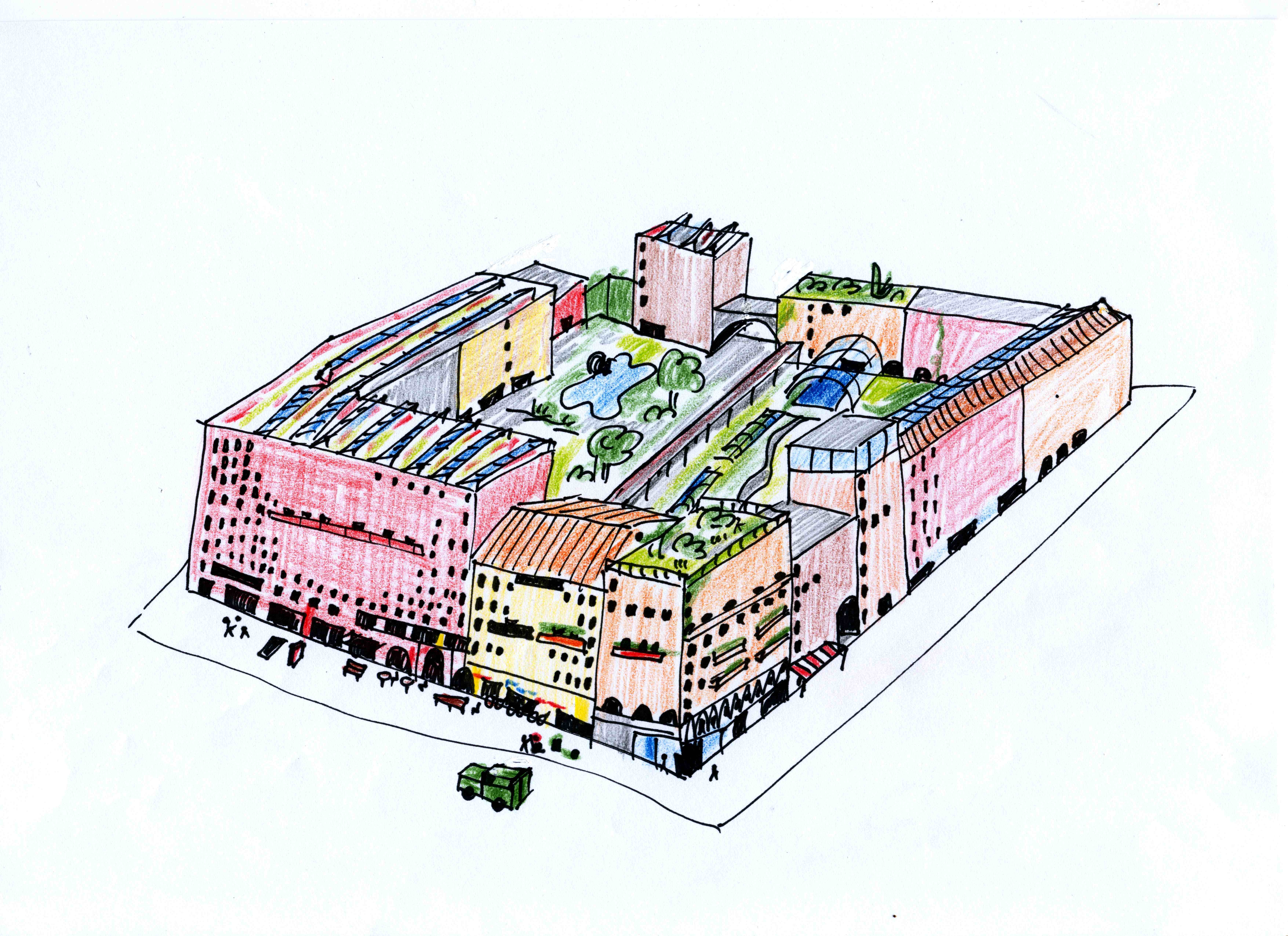
An impression of a typical neighborhood (100m x 100m)
To maintain global equilibriums of power, neighborhoods should be considered as a normal way of life and should have roughly the same basic characteristics. They will all differ in terms of architecture, culture, organization, but they will have a global family resemblance. They will embody the basic equality that we need to deal with each other without risking to get caught in the archaic power games. Wherever you go, you will find a neighborhood, you will be received as a guest and you will recognize institutions and forms of behavior that you know already. You will feel at home on the planet.
These characteristics can be summarized as follows:
- communities of about 500 persons in a compact urban neighborhood
- high density, ca. 200 persons / ha (creates proximity)
- democratic association (cooperative) as a form of organization
- a collective microcenter of some 1000 m2 with a food-depot, a bakery, a bar/restaurant, a tool depot, a laundry saloon and other services
- closely linked with an agricultural basis (one or more farms) in the region which produces most of the food
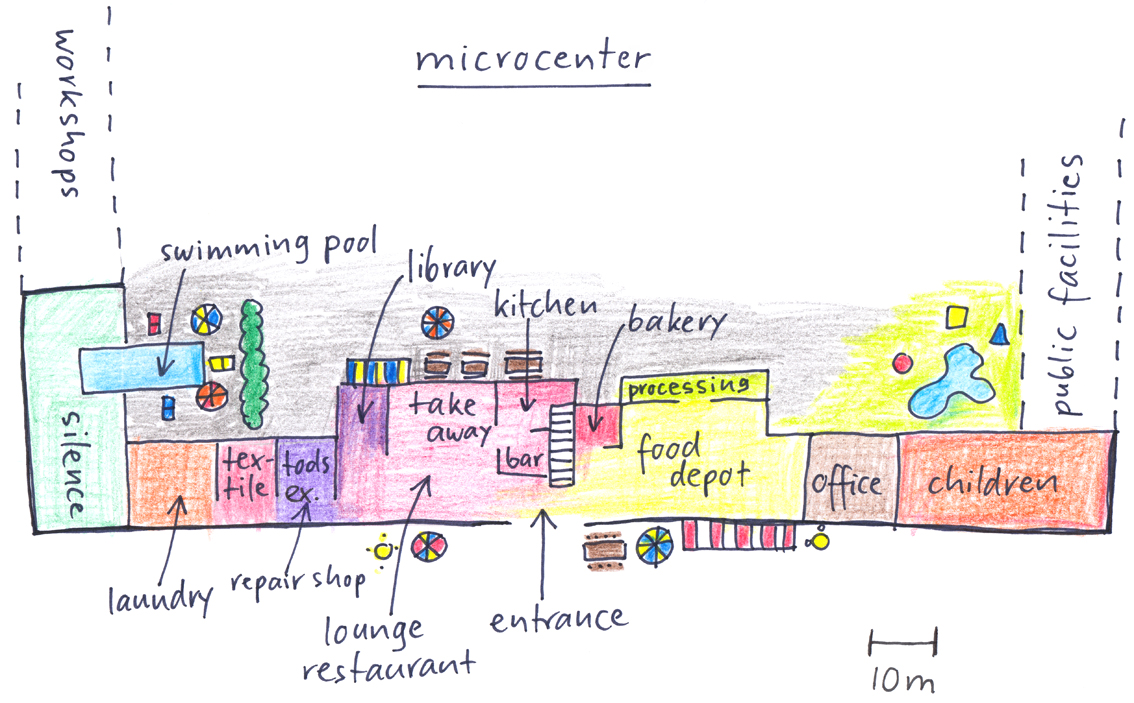
An example of a Microcenter
Such a neighborhood is capable of creating and maintaining a commons of reproduction that covers most of our daily needs. It is still dependent on a variety of public services and exchanges on a larger scale – city, region, territories, continents – but it guarantees a basic form of empowerment and material autonomy.
To produce most of the food (including eggs, dairy products, some meat) for a neighborhood you need between 50 and 80 ha under European conditions (or the conditions of another temperate climate zone). If your neighborhood happens to be situated in a big city, your agricultural base (agrocenter) will be between 20 and 50 km away. This is not a big problem.
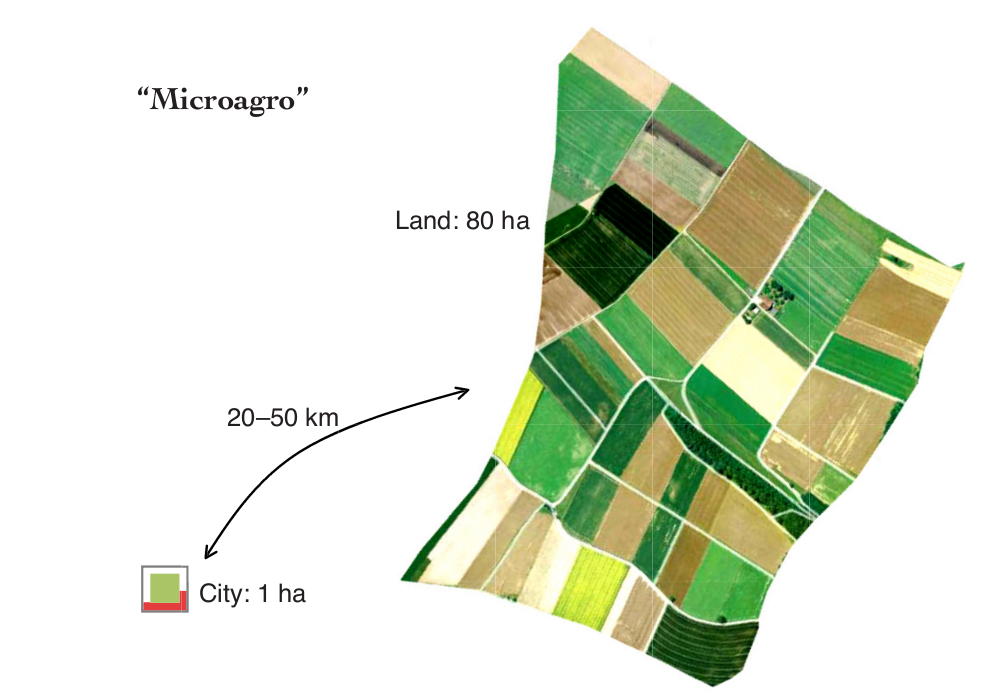
Microagro
To deliver 6 tons of food a week, three times 2 tons, there is a need of a small truck, which can be fuelled by the biogas produced from a small part of consumer waste (or other bio-mass). On the other days, the same truck can be used by an adjacent neighborhood. Other means of transport are also possible, of course: boats, trains, even bicycles. The very simple logistics of moving from A to B full stop replaces the current chain of food logistics, which is responsible for immense waste of moving the goods between distribution centers, supermarkets, shopping centers, not to mention the shoppers’ traveling backwards and forwards. Today packaging and transport make up 50 per cent of the costs of food. What you get in a neighborhood is a kind of embedded supermarket every 100 m, which stays open 24 hours a day within walking distance and accessible by elevators. Such unrestricted opening time prevents excessive storage in the flats (fridges as food graves) and ultimately the huge food waste we observe today (between 30 and 50 percent). It will not take you much longer than a minute to fetch a cooled can of beer.
The suggested size and equipment of the model neighborhood has a lot of essential advantages:
- whatever you need is within walking distance (80 m or 1 minute)
- individual flats can be small (20 – 35 m2 /person), because communal spaces (guest rooms, saloons, lounges, media-centers) are smack in the building
- individual shopping for daily necessities is superfluous (the microcenter is open 24h/365 d), cooked food is provided by the neighborhood-run restaurant (take-away or sit-down)
- services (washing, repairing, mending, child care, basic medical care etc.) are readily available and run according to the requirements of the members of the cooperative
- the distribution of chores (tending of depots, care work, agricultural work) is flexible due to the substantial number of participants; personal predilections can be respected
- the relatively large number of inhabitants doesn’t force anybody into unwanted intimacy, anonymity is possible (you don’t have to know or to love everybody); this in turn makes democratic mechanisms „cooler“: the public doesn’t become private automatically (larger numbers – 1000, 3000 in turn tend to create too much distance and will imply a bureaucratic overhead)
Whatever we appreciate in our lives already – community, security, friendship, family, good company and good food, diversity and stability, privacy, familiarity and freedom – will find a new haven in the global neighborhoods. People have already started to create them.
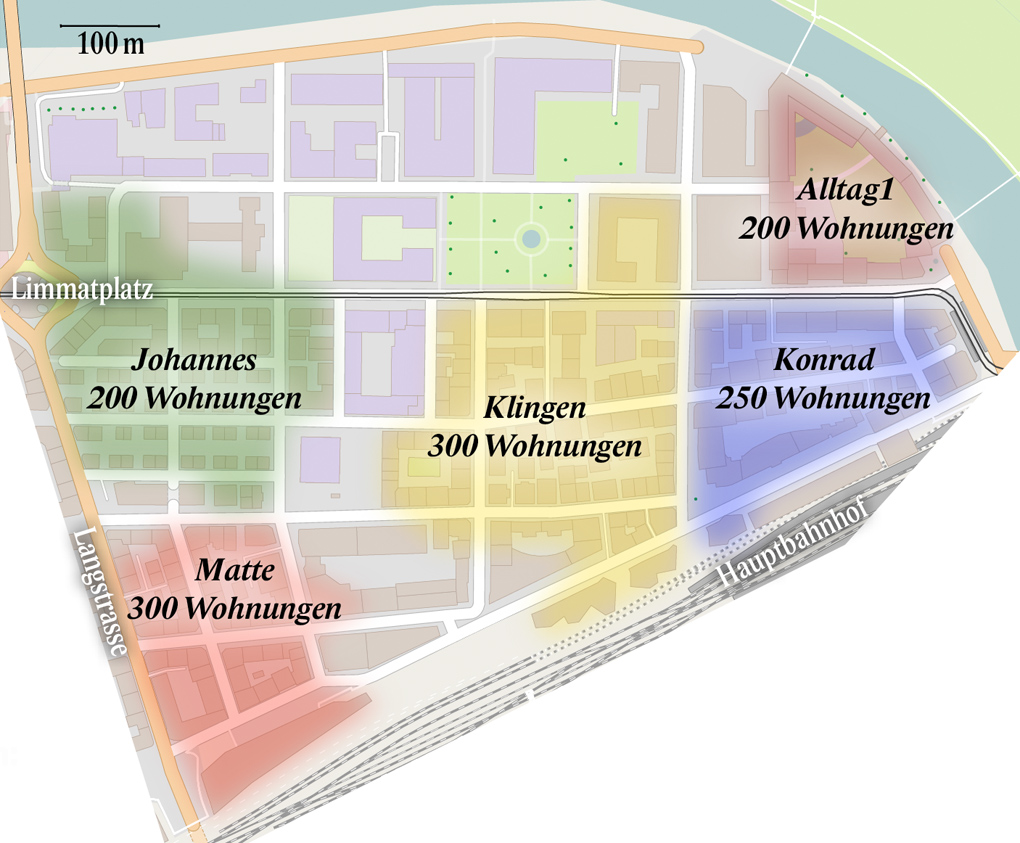
A suggested rearrangement of existing urban structures into four neighborhoods, complemented with the construction of one model neighborhood (Alltag I). (Zurich, Switzerland, www.5im5i.ch)
These neighborhoods can be created from scratch as pilot projects or they can be considered as a process that develops the above features gradually out of existing organizations and situations. They can be the result of changes on larger scales – boroughs, towns, cities, territories. Establishing neighborhood after neighborhood cannot change the world, but without neighborhood initiatives all other transformations will lack a robust basis. Without a clearly defined common project we won’t be able to overcome the present divisions.
basic urban commune
In cities, neighborhoods typically cluster in boroughs (city districts, arrondissements, quarters, etc.) of tens or even a hundred neighborhoods (20'000 to 50'000 inhabitants). This is the area of public services on a larger scale, the first truly political sphere. We call this a basic urban commune.
Basic urban communes have a clearly defined single center that can be reached from all neighborhoods in 10 minutes on foot. In the center you’d typically find a cozy square of about 50 by 50 m, like a zocalo, plaza, piazza or platia. Most services and institutions cluster around this square, which also doubles as an everyday meeting place, and sometimes as a market place for non-essential goods. Shopping can be fun, if you’re not obliged to do it!
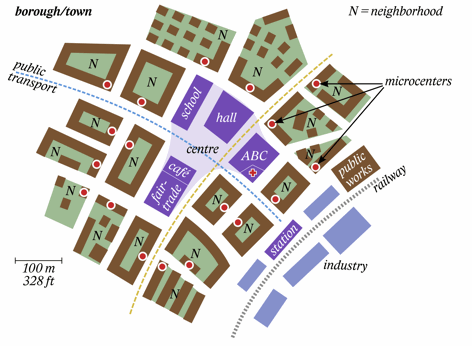
Basic urban commune
In this center you’ll find: a supplementary large food depot for products from faraway countries and for industrial household items (3000m2), primary schools, secondary schools (Gymnasium, high school, grammar school), a citizens’ service center including court, police, social services, administration, the ABC, a health center, various private, commercial or cooperative enterprises (hatters, jewelers, printers etc.), a link to public transport (bus, train).
Basic communes provide public services, like: streets, waste disposal (recycling), water, electricity, fire fighters, industries, and the works.
Public service workers are employees of the basic commune. Instead of shopping centers, basic communes feature TWEEMO (textiles, wood, electr(on)ical equipment, metals, other materials), a synergetic center for the repair, re-use, lending and production of durable household goods.
Basic communes run industries of local or regional importance. The inhabitants of the commune decide the range and quality of products democratically.
Basic communes represent the second ring of the commons.
ABC
ABC means: Anti-Boredom-Center, one of 350'000 on the whole planet. ABCs are open 24 hours/365 days. Your ABC is the most vibrant of all, of course.
ABCs are different in every commune. They usually comprise a large café with bar, a range of saloons, halls, meeting rooms, cabinets and niches, a media room, a game saloon, a terrace going onto the square. All ABCs are linked via Internet; with web-cams and videoconferences live transmissions can be seen on a large screen, and shared events with other ABCs are possible, too. ABCs mean global transparency. They save a lot of physical traveling.
Everybody hangs out, and that means: women, men, adolescents, visitors, guests, and children. It’s also where you meet the interesting species of the so-called locals. ABC, combined with the central square, is the place to be.
So ABCs are the social, cultural and political centers of a basic commune. They also function as a kind of community colleges with a variety of study groups, courses, and classes and provide lifelong learning on a basis of free exchange of knowledge. They make for a creative commons in action.
In the same building as the ABC you’ll find a World Hotel with 50 rooms to accommodate the guests from all over the world. The reception is at the ABC bar. When you arrive in one of the 350'000 ABCs of the planet, you can check the vibes of the place within an hour.
Basic communes are the ideal political modules for democratic rule from the bottom up: neither too small, nor too big. They hold regular assemblies, referendums and propositions. We suggest that one third of all the elected representatives be chosen by the lot, and there be a 50: 50 percent rule of male and female candidates.
large cities and regions
Basic communes can exist on their own, as small towns, or in larger clusters, as large cities. When they form a city, the division of services is somewhat different, for big cities will have additional features and can fulfill some of the tasks of the basic communes more efficiently and on a larger scale: this applies to water, energy supply, police, public transport, waste treatment, schools, hospitals etc. But there will always remain essential services in the hands of the basic communes. On the other hand, the communes are the basic constituents of the democratic government of the city.
In addition to basic communal services, cities provide more specialized public services like: hospitals, universities, theatres, operas, regional courts of justice, public transport, water and energy, cooperatories, banks, recreational facilities (parks, public baths and pools, stadiums), regional industries, branches of territorial or even global enterprises.
A typical city that can provide this extended range of services must have ca. 500'000 inhabitants. There are already a lot of cities of this middle size: Omaha, Bologna, Dresden, Lwiw. Global cities with several million inhabitants will still exist of course – but on the whole they represent special cases. By establishing the first two modules of the commons – neighborhoods and basic communes – even global cities or mega-cities will be ecologically sustainable and socially integrated.
Another important function of regions/cities for the governing of the commons is the organization of industrial subsistence, research, cooperation on a larger scale, pooling and allocation of general resources. This corresponds to what we call banking (incl. stock exchange) today. The demiurgical principle and the necessity of democratic planning require transparent public institutions that are able to replace big business and opaque banking. Large-scale cooperation has two main aspects:
- the definition of projects (research, innovation, “ideas”, inventions, technologies)
- the pooling of the necessary resources (material, know-how, labor power) to realize them
Big city centers are the ideal location for these two functions, which are technical as well as political. Therefore all the “stakeholders” should be able to participate. Citizens are entrepreneurs, investors and consumers at the same time.
Cooperatory/ inventory
The institution that combines these two elements is called a cooperatory/inventory, a permanent fair/exchange/laboratory for the definition of projects of a public impact. A cooperatory is a relatively large complex of exhibition halls, meeting rooms, lobbies, rooms with technical resources, laboratories for trials, tests, workshops for model-making and prototypes, cafés, restaurants: 50’000 m2 in size. It’s the place where “things happen”, a modern form of agora, where groups of citizens, researchers or individual inventors meet to develop their projects and present them to the public. All the know-how, academic and practical, can be mobilized in a “hands-on” atmosphere. In collaboration with universities and professional associations these projects are evaluated by elected juries, which either recommend or reject them. It is also the place where public discussions are held. Their public utility is discussed in the media and decided upon in the pertaining democratic institutions. Public resources are then allocated in the form of loans and the project organizers use the cooperatory (on-line, and off-line) again to find appropriately trained cooperators, the providers of materials etc. We’re talking here about the sector of professional work (the 20 hour/week). So resources can be allocated in the form of money (regional, global) that ultimately goes into wages.
A region is a geographical area that covers the surface necessary to produce most of the food of the city. It’s an area where you can reach most points by traveling 30 minutes by public transport, about 10'000 km2 under European conditions of relatively dense population. Within this region you’ll find agricultural surfaces, forests, rivers, lakes, moors and some local industries like quarries, sawmills, recycling factories etc. Industrial facilities will all be connected with public transport.
600 territories
Looking at any map, you can discern that territories of a certain size seem to make sense: states (US, Mexico), Länder (Germany), régions (France), provinces, or small countries like Costa Rica, Estonia, Scotland or Belgium. Most of them are around 50’000 km2, have a population of 10 million and are geographically compact. Pennsylvania is a bit larger; Massachusetts smaller, Denmark or Switzerland are about right the right size. The main reason behind it is transport, for in such a territory you can reach any point in a 2 hours drive/train trip, which means you can do a job within this territory in one day without having to look for a hotel room. If we apply one or the other criterion, a lot of existing entities fall into this category. The term “territory” can be used relatively loosely here. Compared with large nations or mere regions, territories are a promising medium-size category that has, among many others, a lot of ecological and political advantages.
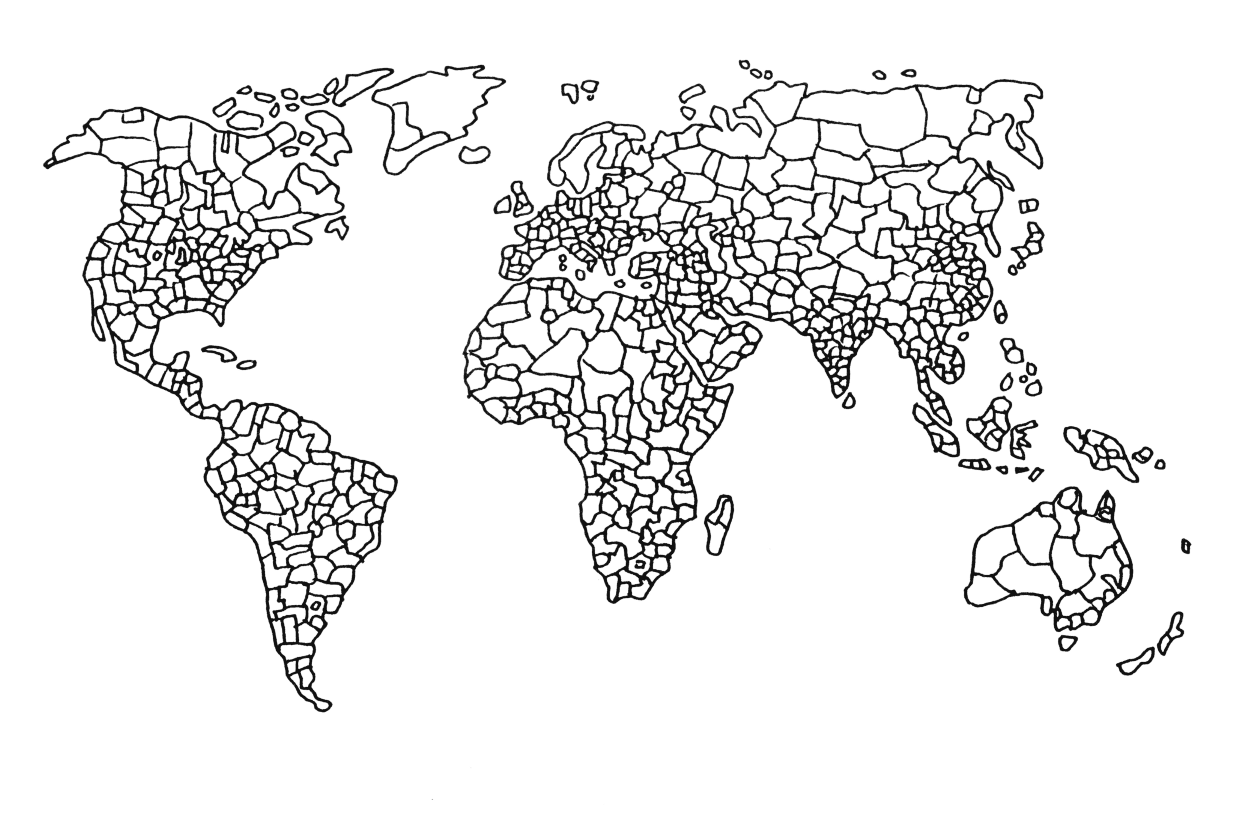
World map showing territories;
the borders shown do not correspond to any existing or suggested territories
Most importantly territories have the potential to be the entities where ecological integration and national/political neutralization is practicable. Giving more real autonomy (in the physical and political sense) seems a good way to reduce the impact of greater nations that have become dysfunctional in many respects anyway. To achieve a balanced global organization of the commons, we need more evenly matched units: small enough to be dependent on each other, yet large enough to function independently for a certain time. So a global cooperative of territories seems a good role model for such a democratically structured institution.
Most formerly national functions can easily be taken over by territories and work better: higher education, train systems, specialized hospitals, electricity grids, banking, industries, police etc. There aren’t many things that big nations can do better than smaller countries. For an efficient health or social service, you do not need nations to be big: small nations like Denmark (40’000 km2, 5.5 million inhabitants) or Norway offer quite decent public services. Danish or Swiss universities are as good as German or Russian ones, and so are Swiss or Belgian hospitals.
Territories are well adapted to a combination of direct and indirect forms of democracy. People still meet each other regularly or occasionally, which makes communication easier, delegates and administrators are not too much cut off from ordinary citizens, political ambitions don’t fly too high. Direct contacts are efficient, cut administration costs and make monitoring easy. Scandals can be detected and dealt with at short notice. Shit happens, but small shit. It happens under your eyes, as it were. A lot of commons can be managed in this sphere, particularly natural ones. Territories are a form of decentralization, which also works for large-scale services and industries. Risks can be balanced off in units of 5 million inhabitants. You don’t have to rely on bureaucratic behemoths responsible for 80 or 300 million persons. All you need is a territorial parliament of 200 to 400 delegates and an administrative board of 7 to 11 members. These delegates could also double as delegates of the 5 to 10 regional councils in a territory, so that you don’t get too much political “overhead”.
Subcontinents, planet
With the establishment of railroad systems and canals, subcontinents and continents have become the real physical areas of our social metabolism. For more than a hundred years dysfunctional nations have tried to accommodate this reality with traditional borders, identities and institutional particularities, with path-dependent aberrations of all sorts (like wars). The defense of national markets and the corresponding weakness of purely supra- or poly-national institutions (EU) have so far prevented the emergence of authentic and democratic continental cooperation. It is obvious that existing blatant inequalities have paralyzed relaxed forms of cooperation. As long as there are dramatically under-equipped territories, there will be no end of such phenomena like forced migration, fences, deaths on leaking boats. Only a double-thronged strategy of strengthening the territories as providers of decent public services and of complementing them with functional, ecologically sound forms of cooperation on the continental level can succeed. Once the continental institutions take on the form of cooperatives of members of comparable size (modules), mutual trust will spread, a prerequisite for the commons to be governed together.
Subcontinental and global cooperation is particularly important for the just attribution of non-local, basic resources and for industrial subsistence. We neither own the resources, which we happen to sit on; nor do we own the air that happens to flow across our territories. It would be absurd to ship and distribute all the resources (e.g. metals, oil) evenly across the whole planet: for ecological reasons it’s best to use them on the spot and to share the products created there. For the new ecological, modular and robust technology that we need (mentioned above), we need large-scale cooperation. We can produce all the electric motors and equipment, processors, machines, chemical components etc. on a few sites for the whole planet. Like Lego-blocks they could be manifold modules that can then be assembled, modified or combined in all spheres, even down to single neighborhoods. The problems we are faced with, like competition, systemic incompatibility, excessive redundancy, parallel development costs, could be solved. At the moment powerful monopolistic forces are pushing in that direction already, yet, alas, not to solve our technical problems, but to defend the profits of their owners. We cannot break the power of these monopolies by going back to lower levels of production. Small is not beautiful in this case, but rather a signpost for the road to defeat.
Continental and global cooperation is most urgently needed to balance the unequal standards of equipment and resources in the territories. Transfer of resources must go to emerging or existing institutions of the commons, to neighborhoods, towns and territories. Not to governments or corporations. A basic package of services and technical equipment for all inhabitants of the planet must be made accessible. Food subsistence (microagro) can be realized almost everywhere. This decent infrastructure must be defined in concrete, technical, not just financial terms. It does not stand to reason, why this transfer should take the risky and tortuous detour of macro- or micro loans to create new markets, i.e. to try to jump-start a machine of which we know that it won’t work properly and in the long run. It can be instituted in the form of twinning between the towns in the over-equipped north and the towns or territories of the under-equipped south. This transfer cannot be conceived as a repetition of the disastrous development of market economies, it must be seen as a reparation for colonial exploitation, slavery or more recent robberies like land grabbing and mining. People living on this planet have the right of a good life based on subsistence and institutions of the commons.
A common future, a global plan
5 spheres of the commons are sufficient.
What we have roughly described above is an institutional framework for a global commons.
The 5 spheres:
- neighborhood
- basic commune
- city / region
- territory
- planet
are based on a variety of social, ecological and organizational considerations. Minimizing the use of space, energy, transports and resources and at the same time creating areas of democratic empowerment are two of the most important dimensions. This should permit to shrink the actual hypertrophic economic throughput to one fifth or less. If we share more, if we think about our true needs beyond the iron cage of “consumer society”, then we can do with less without any loss of quality of life. On the contrary, we’ll live better lives, more relaxed, more sociable and playful ones, because the need for formal work and discipline will decline in the same measure. We can imagine a 4 by 4 day: 4 hours of formal work in the productive sector at large, 4 hours of house work in neighborhoods and on the fields, 4 hours of communicative and political work, 4 hours of self-improvement and recreation. And the rest for some sound sleep.
The result is a kind of non-economy that can’t be measured with the traditional GNP-methods. A large part of our activities will not be monetarized and thus elude macro-economic measurement. So, officially we will see dramatic de-growth, whereas in real life we will see an equally dramatic explosion of creativity, enjoyment and cooperation.
Who cares about the figures and the ratings? We’ll rate ourselves. AAA forever.
What we suggest is a global understanding on these spheres, their functions and institutions. If we can agree on commons-boundaries of equal size and importance, then the basis of a peaceful world is laid. Dismantling the old nations of the 19th century, especially the super-nations, that are actually machines of domination and exploitation, is part of the process of the establishment of a global commons. We need a new beginning without the baggage of the past.
Get real!
We don’t need national ideologies to define our identities. Neighborhoods will allow us to develop and present our personalities in a direct everyday context. The new communes and regional cities will offer countless aspects of participation and identification, even pride (have you seen our ABC?). The territories will put us on an equal global footing and will also be part of our collective identity. This doesn’t have to, actually shouldn’t be ethnic or linguistic. Of course, this means shedding parts of our history – no big loss! Let’s forget our old quarrels and divisions; let’s move from myths to reality!
Are you ready for it ???
Having reached peak car, peak inequality, peak global warming, peak patience - we’re ready to unravel the fabric of our old lifestyle and to knit the new sweater of climate justice, the commons, democracy and cooperation.
Good riddance! It’s (almost) over!
Just a little push and we, the global 99.9 per cent, will take over the theatre and put on a new play. After the tragedy of the markets, we’re ready for the comedy of the commons.
The end has been announced for a long time; at the moment we’re living it. Do we need more Fukushimas, Katrinas, Sandies, crazy (civil) wars and failing states, decaying bridges, unpayable debts? The apocalypse is here! The thing is falling apart. There is no center to control the mad machine and no pilot in the cockpit. We’re alone.
But we’re many – from Rio to Instanbul, from Paris to Hongkong, from Baltimore to Athens – a global uprising is happening. We have all the resources, the knowledge and the contacts to establish and manage a different social and economic way of life. So:
We are ready for the future of the commons.
